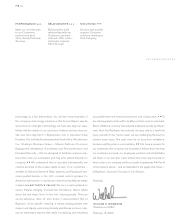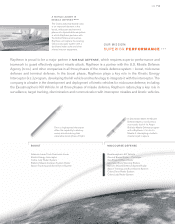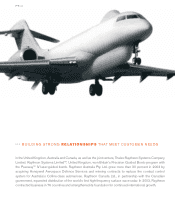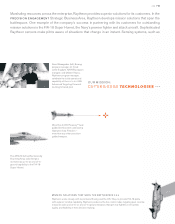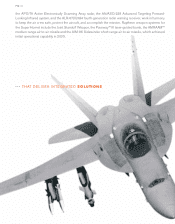Raytheon 2003 Annual Report Download - page 14
Download and view the complete annual report
Please find page 14 of the 2003 Raytheon annual report below. You can navigate through the pages in the report by either clicking on the pages listed below, or by using the keyword search tool below to find specific information within the annual report.
777 P12
INTELLIGENCE AND
INFORMATION SYSTEMS
333
INTELLIGENCE AND INFORMATION SYSTEMS (IIS),
which reported sales of $2 billion in 2003, is on the leading
edge of transformation in the intelligence community, the military
services and the civilian agencies of government, providing solutions
in signal and image processing, geospatial intelligence, air- and
space-borne command and control, ground engineering support,
weather and environmental management, and information tech-
nology. 33A major 2003 mission integration win was the contract
for the U.S. Air Force Distributed Common Ground System (DCGS)
– the backbone of both current and future intelligence and informa-
tion systems. The U.S. Air Force also extended Raytheon’s Global
Broadcast System (GBS) contract for two years. 33Operational
support continued for the U-2 and Global Hawk systems and
Raytheon delivered the first production Global Hawk Ground Station
Mission Control Element, which manages the unmanned aircraft and
its sensors and controls a number of air vehicles simultaneously. The
contract was extended to Consolidated Field Support for the U-2 air-
craft. 33IIS recently transitioned to operation an advanced intelli-
gence management program on the date we committed to deliver
four years ago and delivered another classified system that dissemi-
nates time-critical imagery and near-real-time mission planning data
to war fighters. 33Business with the National Security Agency grew
with wins in three classified programs. Raytheon also expanded its
special technical support to vital classified intelligence and law
enforcement activities. 33The Federal IT business base expanded
with the win of a five-year contract for information technology opera-
tions and maintenance for NASA’s Earth Observing System (EOS).
33Multiple customers selected Raytheon to define requirements in
key mission areas. Raytheon won study contracts to identify advanced
architecture concepts for the next generation weather system from the
National Oceanic and Atmospheric Administration (NOAA) and a
requirements definition contract for the transformational architecture
for the Air Force Military Satellite Communications (MILSATCOM)
program. The company was also selected to perform architecture
definition for the next generation national signals ground study.
33IIS assumed management of the Homeland Security Strategic
Business Area in late 2003 and is serving this dynamic market with
solutions in national border management, key enabling information
technologies and secure communication systems. 33The
Garland, Texas, site achieved Capability Maturity Model Integration
(CMMI®) Level 3 certification rating in 2003 and other locations are
on schedule to duplicate this accomplishment in 2004. 33IIS
capabilities are helping pave the way to transformation in all our
customer communities.
Raytheon won the contract to provide the next generation Distributed Common Ground
System (DCGS), building on 25 years of experience supporting DCGS worldwide
operations. DCGS, the backbone of current and future intelligence and information
systems, integrates multiple intelligence systems into a single, worldwide enterprise,
delivering time-critical, decision-quality information to leaders who need it most. The
wireframe in this image shows how DCGS integrates worldwide intelligence systems
to provide decision-quality information for the war fighter.
MIKE KEEBAUGH
President
3



